 High Latitude Sailing,
High Latitude Sailing,
Self-Sufficient Sailing Techniques for Cold Waters and Winter Seasons
By Jon Amtrup and Bob Shepton
Hardcover, 198 pages, $35
Adlard Coles, Bloomsbury Publishing Plc, London
Written by two extremely experienced ocean voyagers, High Latitude Sailing provides exactly what its title claims: techniques, ideas, and strategies for self-sufficient sailing in cold waters. But it is also an inspirational book. Before you’ve even begun reading the text, Bob Shepton’s gorgeous photographs will have you running to the chart table to plan your own voyage to the superb wildernesses of the far north and south.
A renowned sailor and mountaineer, Bob Shepton has voyaged more than 130,000 nautical miles in his modest 33-foot GRP Westerly sloop. Most of those miles have been in the high latitudes, including two trips to Antarctica, multiple trips to Greenland and Arctic Canada, and two transits of the Northwest Passage. To my knowledge, Bob is unique in the sailing community in having received, in addition to many sailing awards, the Piolet d’Or, mountaineering’s highest honor, for his pioneering sailing-to-climb expeditions to Greenland. He knows what he’s talking about when it comes to self-sufficient, high latitude sailing.
Norwegian sailor and journalist Jon Amtrup is similarly someone you should listen to when planning a high latitude voyage. A member of the Explorer’s Club, he has circumnavigated Svalbard and made extensive voyages in the North Atlantic, Greenland, and Norway, including in winter. He assists expeditions with weather routing and has delivered a number of yachts.
High Latitude Sailing opens with a chapter on “Preparing Yourself,” which I thought an excellent beginning. In general, I think too little attention is given to mental preparation for challenging voyages; it’s easier to focus on material preparation (boat and gear). To a certain extent, material preparation aids in mental preparedness, but it’s important to face directly what kind of voyage you are planning and what level of mental stamina it will require. This first chapter does that, mostly by covering risk assessment, pre-departure research, contingency planning, and crew dynamics. The emphasis of this chapter – and the entire book – is on cultivating self-sufficiency: understanding and preparing for the fact that you will be in a wilderness where you’ll have to rely on yourself and your crew alone.
Other chapters provide solid advice on the material preparation that will put you in a good position to be self-reliant throughout the voyage. The authors cover everything from ideal hull construction to communications technology to the clothing they’ve found to work best. Bob Shepton’s chapter “Sailing in Ice” provides instructive advice, enlivened by his first-person narratives of experiences in the Arctic and Antarctic. Those of us who cannot afford the perfect aluminum expedition yacht will appreciate how much he has done with his small GRP production yacht. The Safety chapter includes ideas not only on the usual suspects – EPIRB, man overboard procedures – but also on specific high latitude concerns, including the behavioral signs of an aggressive polar bear.
Parts of the chapter on weather will be familiar to voyagers already accustomed to offshore passage-making and considering expanding their horizons further north or south. But in addition to general topics like GRIB files, readers will find insights on ice charts and the quickly changing conditions of polar regions. The Anchoring chapter is an excellent reminder to even the most experienced sailors that securing your boat for the night in the high latitudes can sometimes be far from truly secure; the authors give good tips on how to deal with this.
The book then turns to high latitude sailing areas. There are brief overviews of Svalbard, Greenland, Iceland, Cape Horn, Antarctica, and Patagonia, and full chapters on the Northwest Passage, Russia’s Northeast Passage, and South Georgia Island. The Northwest Passage chapter is written by Trond Aasvoll, a Norwegian sailor and Explorer’s Club member who circumnavigated the North Pole in 2010 and 2011 aboard a 36-foot GRP yacht built in 1977. Russian professional sailor Elena Solovyeva contributed the informative Northeast Passage chapter, and Bob Shepton the South Georgia chapter. The book ends with an up-to-date appendix on Antarctic Regulations and with a list of further reading, both inspirational and practical.
High Latitude Sailing gives sound advice and practical strategies for making a successful, self-reliant voyage to the far north or south for anyone planning to venture there. It is not exhaustive, but it covers all the major points and provides readers with excellent knowledge and tools. Furthermore, its theme is self-sufficiency, and self-sufficient sailors will consult multiple sources to augment their own intelligence, skills, and experience.
But the book encompasses a broader readership than potential high latitude sailors. It will also appeal to armchair adventurers and to experienced high latitude sailors, thanks to the beautiful color photographs. These make the book a gem to pick up and leaf through at any time: to admire the stark beauty of the polar wildernesses, to reminisce about your own trips to these places, or to inspire you to go yourself. Whether you’re a climber like Bob Shepton, drawn to the spires and walls of Greenland and Baffin, a skier drawn to the glaciers of Antarctica or South Georgia, a wildlife enthusiast hoping to photograph a polar bear or muskox, or a sailor first and foremost, drawn to the experience of crossing challenging waters to reach remote and beautiful anchorages, this book will not only keep you dreaming and planning, but will give you practical advice on how to get ther

